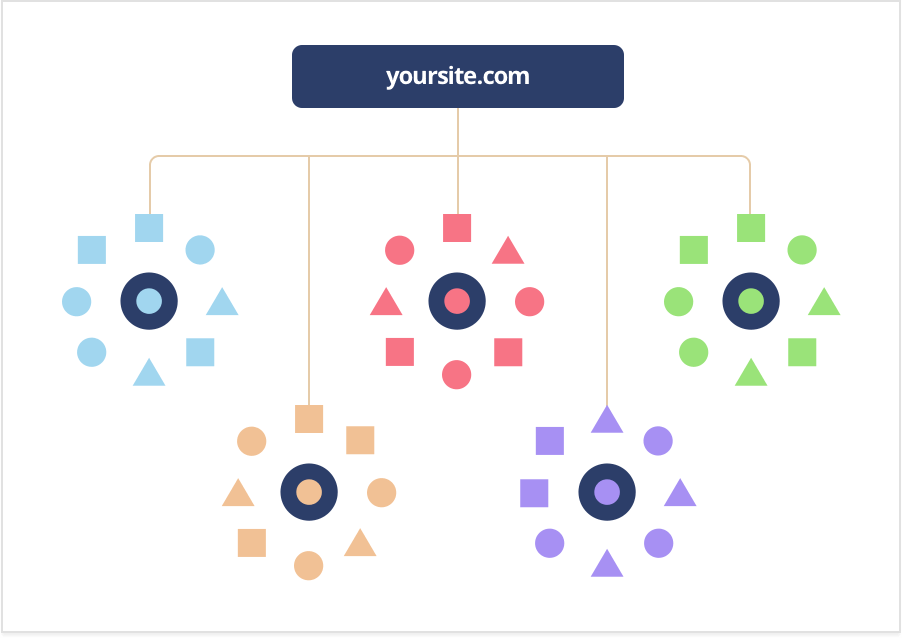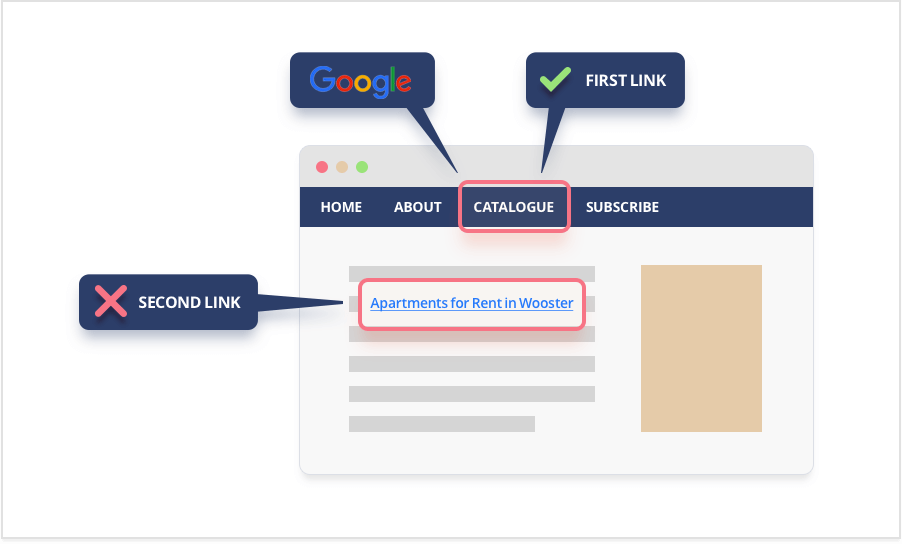Your website is an interconnection of pages.
Whatever SEO and user experience issues it has, the problem always boils down to its two basic elements:
- The pages themselves.
- The connections between them, a.k.a. internal links.
This makes internal links your second biggest priority.
So today we’ll look into all the ways internal links might be hampering your site’s performance.
1. Revising Website Structure
An optimized website is a structured website.
Too many websites have no clear organization at all.
Why does this happen?
Typically, it’s because website content is added sporadically, without any actual strategy. Sometimes this is due to business needs changing and things that were once important no longer are.
To figure out what you’re working with, you need to get a bird’s eye view of your website architecture.
Ensuring a Consistent Structure
As Google’s John Mueller puts it, the way your pages are interlinked provides Google with “context.”
Internal links helps the search engine understand how your pages are related and what their roles are.
So you need to make sure your website is not a mess of randomly interlinked pages. This make the site’s context unclear.

You also need to make sure the type of structure you use is actually the optimal one.
Which one is the one depends greatly on your business needs, but here are some options to consider:
- A flat website structure is when there’re only two levels of hierarchy implied – the homepage itself and the rest of the pages (linked to directly from the homepage). Obviously, this one can only fit smaller websites and becomes really confusing when we’re talking hundreds and thousands of pages.

- A pyramid structure is when you start with the homepage and go down to categories, subcategories and single pages within them. That’s one of the most common ways to arrange an ecommerce store.

- A thematically clustered structure is when you group your content by themes. And not in a pyramid manner, but rather having one “pillar” page in each cluster and a number of subordinate pages supporting it. The pillar page, in this case, covers the topic in general. While the subordinate ones, focusing on specific long tails, all link back to the “pillar”, thus “voting” for its authority on the topic:

This tactic got especially popular with websites relying heavily on blogging and proved itself well in some experiments.
Optimizing for Click Depth
I’m not about to parrot the age-old three-click rule.
Many experiments have shown the number of clicks affects neither user satisfaction, nor success rate, so there’s no particular reason to make all of your content accessible in three clicks solely for the sake of UX.
However, you still need to consider click depth in terms of SEO, because pages’ depth affects their importance for Google.
Sometimes click depth issues may simply occur due to negligence.
So start by identifying your most important pages. Make sure they didn’t get buried deep by accident.
Click depth issues quite often result from your pagination.

I strongly recommend revising your pagination.
Eliminating Orphan Pages
Another pretty common issue is orphans – the pages that got left out from your website structure altogether, because:
- They have no internal links pointing to them. Quite likely, these are some older pages that had been linked to from removed content or new pages you forgot to include into the navigation.
- You’ve messed up with nofollowing and noindexing. Like if you decided to remove your paginated pages (I’ve seen people do so…) from Google’s index. The deeper pages the paginated pages linked to would remain reachable to users, but not to Google bot:

The problem with fixing orphan pages is that they’re hard to find.
You might search for them in the XML sitemap (in case they were added to the sitemap but not the navigation) and Google index (in case Google knows about them because of external links).

Also, fire up a crawling tool to scan your website as the Google bot does and check if any disallow instructions are standing in its way.
Fixing Content Duplication
Another common issue is that inconsistent interlinking might create duplicated versions of your pages.
Like when some of your internal links have trailing slashes, and some of them don’t. In case there’s no redirect set up, these two URLs look as if separate duplicate pages:
https://example.com/page1/
https://example.com/page1
The same thing might be happening with www and non-www versions of your site, tracking parameters in the URLs and other cases of content duplication.
The thing to keep in mind here is that you shouldn’t just set the redirects up. You need to fix the internal links themselves to avoid constantly triggering unnecessary redirects.
2. Auditing the PageRank Flow
I won’t go into how PageRank actually works. I’ll just mention that, for the past 20 years, PageRank has been a key Google ranking signal.
That’s why you want a well thought-out website structure – one that naturally passes authority to your most important pages.
However, you still need to make sure the PageRank your website earns externally flows unhindered across the website and doesn’t go to waste.
Stopping ‘Nofollow’ PageRank Evaporation
I don’t usually fall for whatever Google reps have to say, but the official statement (at least one of them) goes as follows:
“When you have a page with ten PageRank points and ten outgoing links, and five of those links are nofollowed… the five links without nofollow would flow one point of PageRank each.”
This implies that nofollowed internal links “evaporate” PageRank from your website.
The PageRank points flow away from the original page through the link but never land anywhere else.
So, if you’re still nofollowing your internal links, there’s an easier solution:
Make sure you don’t have too many internal links pointing to your less important content.

Releasing PageRank from Dead Ends
Another trap for your PageRank flow is dead-end pages – the pages that don’t pass the PageRank they’ve received anywhere else on your site.
This might happen when the pages simply have no outgoing links to follow (which is a vexing experience both for users and the bots).
Also, dead ends are your:
- Noindex pages.
- Broken links to 4xx and 5xx pages.
- Redirect loops.
- And so on.
These issues tend to reappear every now and then as your website changes and evolves. So auditing your broken links, redirects, and robot instructions must be your regular habit.
3. Revising Anchor Text
Besides building hierarchy and passing authority, internal links play into your pages topical relevance.
And although these days it takes way more to rank a page for a keyword than just anchor text, Google still uses them to understand what your pages are about.
Adding Meaningful Anchors
Both SEO- and user experience-wise, there’s little sense in meaningless anchor text like “click here”. They just don’t let the bots and the users know where the link is leading them to.
So, given the fact that internal anchors are still used by Google and cannot lead to a penalty, you have every reason to put some keywords into them.
However, the thing to keep in mind here is the possible (though somewhat questionable) first link priority rule.
It states that if “Page A” links out to “Page B” twice, it’s only the first anchor text that counts to Google.
Thus, it might be a good idea to make your top navigation (which search engine bots discover before they get down to the main content) keyword-rich:

Cutting Down on Image Links
Google’s John Mueller warns against using image links without anchor texts:
“The one thing I would avoid doing is changing anchor text into an image. So if you have… a fancy font or something that you want to use on your pages and you change a link from being a text link to an image link and you don’t have any textual kind of connection with that image for that link then it’s really hard for us to understand what the anchor text is supposed to be.”
So, if you link between pages with images and for some reason wish the things to stay this way, at least make sure every image has a descriptive alt text.
Conclusion
I could go on and on about the various internal linking tactics and best practices. But the three covered aspects (hierarchy, authority, and keyword relevance) – are the three pillars you can start off from.
Finally, remember to:
- Mind how a link’s importance is affected by its position on a page.
- Be careful with onclick= links for JavaScript-based websites and other possible indexation problems.
- Make use of relevant Schema.org markup for breadcrumbs, internal bio links (because of E-A-T), and lists (now available for recipes, movies, courses, and articles).
More Resources:
- 3 Big Reasons Why You Must Audit Your Internal Links
- Related Articles & Internal Linking: Will It Help Your SEO Results?
- Where Links Fit Within the Marketing Funnel
Image Credits
Featured Image: Created by author, April 2019
In-post images and screenshots created/taken by author, April 2019





![[SEO, PPC & Attribution] Unlocking The Power Of Offline Marketing In A Digital World](https://www.searchenginejournal.com/wp-content/uploads/2025/03/sidebar1x-534.png)